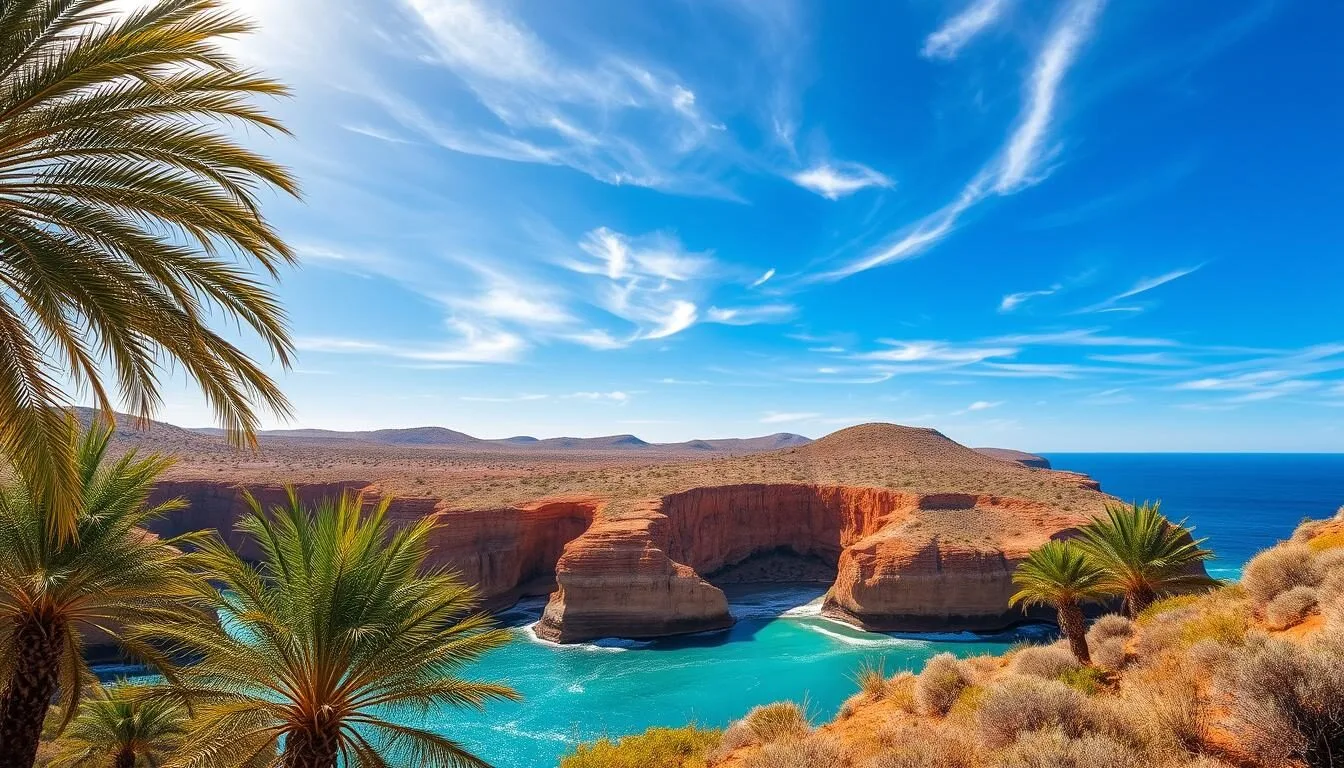✓ Accommodations✓ Flights✓ Rental Cars✓ Tours & Activities
Imagine standing on the rugged shores of Western Australia, surrounded by the pristine beauty of one of the country’s most spectacular coastal wilderness areas. You’re about to discover the breathtaking Cape Range National Park, where dramatic gorges meet stunning beaches and crystal-clear waters.
This natural paradise offers a unique blend of landscapes and activities that cater to every type of traveler. From swimming with whale sharks to hiking through ancient gorges, you’ll find unforgettable experiences in this remarkable national park.
With its proximity to Ningaloo Reef, the park provides unparalleled opportunities for snorkeling and marine wildlife encounters. Get ready to explore one of Australia’s most captivating destinations.
Discovering Cape Range National Park
Located in Western Australia, Cape Range National Park offers an unforgettable experience. This park is a treasure trove of natural wonders, from rugged gorges to pristine beaches and the world’s most accessible fringing reefs.
Location and Geography
Cape Range National Park is situated in the heart of Western Australia, near the town of Exmouth. The park’s unique geography is characterized by its rugged limestone range, which plunges into the ocean, creating a dramatic landscape.
The park is home to the Ningaloo Reef, one of the world’s most pristine fringing coral reefs. This combination of land and sea creates a diverse range of ecosystems.
| Feature | Description |
|---|---|
| Rugged Gorges | Deep, rugged gorges carved into the limestone range. |
| Pristine Beaches | White sand beaches perfect for relaxation and snorkeling. |
| Ningaloo Reef | One of the world’s most accessible fringing coral reefs. |
Why Visit Cape Range National Park
Visiting Cape Range National Park is a must for any nature lover or adventure seeker. The park offers a rare combination of landscapes, including deep gorges, pristine beaches, and the Ningaloo Reef.
Unparalleled wildlife viewing opportunities are available both on land and in the water, with chances to spot rare species in their natural habitat.
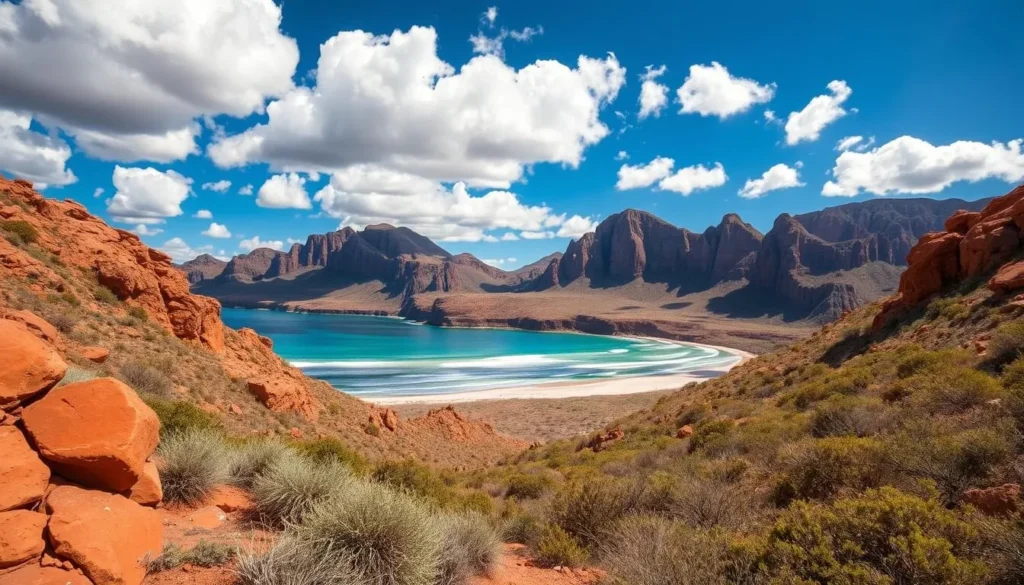
The park’s diverse ecosystems support an incredible variety of plant and animal life, making it a paradise for nature enthusiasts and photographers. To truly appreciate all the park has to offer, plan to spend at least 3-4 days exploring its many attractions and natural wonders.
- Experience a rare combination of landscapes.
- Enjoy unparalleled wildlife viewing opportunities.
- Access world-class snorkeling directly from the shore.
With its unique landscapes, diverse wildlife, and accessible reef, Cape Range National Park is a destination that has it all. Camping here for at least one night is a must to make your trip even more unforgettable.
Best Time to Visit Cape Range National Park
To make the most of your visit to Cape Range National Park, timing is everything. Understanding the seasonal variations will help you plan your trip according to your preferences and the activities you have planned.
Seasonal Highlights
The park offers unique experiences throughout the year. Winter months (April to August) are ideal for wildlife encounters and comfortable temperatures, with averages ranging from 15°C to 25°C. Summer months (November to March) are perfect for witnessing turtle nesting, although the heat can be challenging.
- Winter brings peak whale shark encounters and ideal conditions for viewing wildlife.
- Summer is characterized by high temperatures and turtle nesting season.
Weather Considerations
Weather plays a significant role in your visit. Be prepared for temperature variations and occasional rainfall during winter, which can transform the landscape. Water temperatures remain pleasant year-round, ranging from 22°C to 28°C.
| Season | Temperature Range | Highlights |
|---|---|---|
| Winter (April-August) | 15°C – 25°C | Peak whale shark encounters, ideal wildlife viewing |
| Summer (November-March) | Up to 38°C | Turtle nesting season |
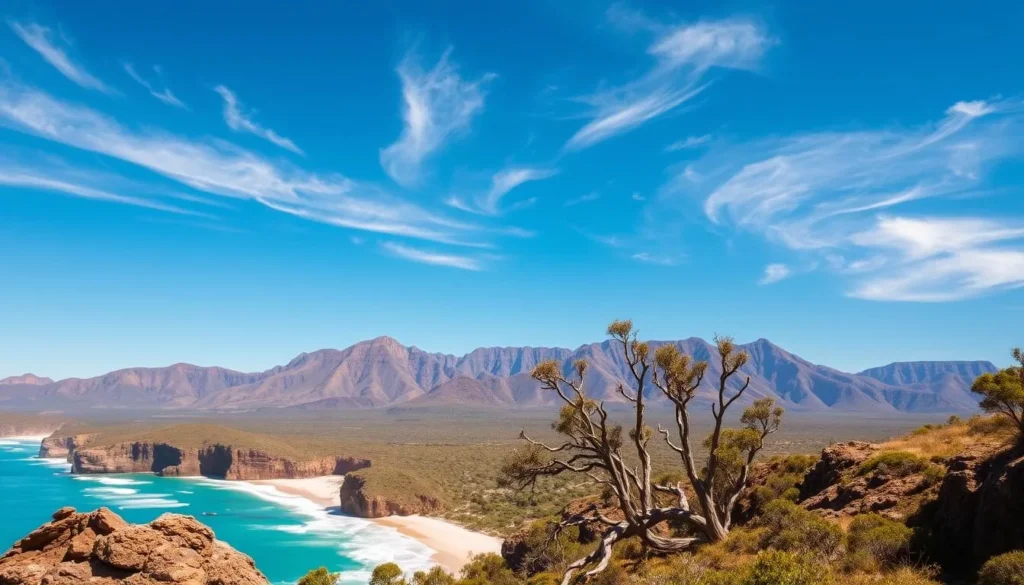
Exploring Ningaloo Reef: Marine Adventures
As you venture into the crystal-clear waters of Ningaloo Reef, you’ll discover a world of marine adventures that await you in Cape Range National Park. The reef is renowned for its vibrant coral and diverse marine life, making it a paradise for snorkelers and scuba divers.
Snorkeling Spots in Cape Range National Park
Ningaloo Reef offers numerous snorkeling spots that are teeming with marine life. Some of the best spots include areas with coral formations where you can see a variety of fish species and even encounter gentle giants like manta rays and whale sharks.
The reef’s clear waters provide excellent visibility, allowing you to fully immerse yourself in the underwater world. Snorkeling tours often visit these prime locations, ensuring that you get the most out of your experience.
Swimming with Whale Sharks and Marine Life
One of the most unforgettable experiences at Ningaloo Reef is swimming with whale sharks. These magnificent creatures migrate to the area between March and July, providing a unique opportunity to interact with them in their natural habitat. Guided tours are available from Exmouth, operated by experienced professionals who ensure responsible wildlife interactions.
During your visit, you may also encounter humpback whales migrating through the waters between June and November, as well as shark species that call Ningaloo Reef home. The area is protected, with strict regulations in place to safeguard the marine life, including limits on swimmer numbers and minimum distance requirements.
Top Beaches in Cape Range National Park
As you explore Cape Range National Park, you’ll discover some of Western Australia’s most stunning beaches. The park is renowned for its beautiful beach access and diverse marine life, making it a perfect destination for beach lovers and adventure seekers alike.
Turquoise Bay
Turquoise Bay is a gem within Cape Range National Park, known for its vibrant turquoise waters and white sandy beach. This bay is ideal for swimming and snorkeling, with an abundance of marine life to discover. The bay’s calm waters make it a great spot for families.
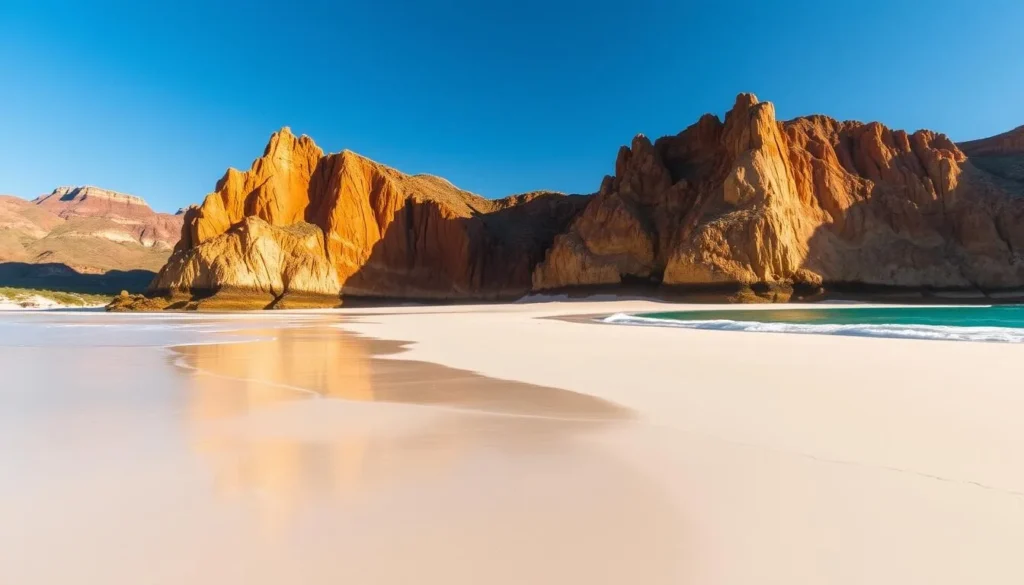
Sandy Bay
Sandy Bay is another picturesque beach in Cape Range National Park, offering a serene atmosphere and clear waters. It’s a great location for those looking to relax or enjoy water activities like snorkeling and kayaking. The bay’s proximity to other attractions makes it a convenient choice for visitors.
Osprey Bay
Osprey Bay stands out as the largest camping location within the park, with 46 campsites nestled among the coastal dunes. Apart from its scenic campground, Osprey Bay offers a sheltered beach with calm, clear waters perfect for swimming, snorkeling, and paddling. Visitors often spot turtles while enjoying these activities. The bay’s protected waters are also ideal for kayaking and stand-up paddleboarding, providing a unique perspective on the coastline.
When planning your visit, remember that booking well in advance is essential, especially during peak seasons. Osprey Bay campground provides basic facilities, including drop toilets, but visitors need to bring their own supplies, as there are no showers or drinking water available.
Hiking Trails and Gorges
Cape Range National Park offers some of the most spectacular hiking trails and gorges in Western Australia. The park’s unique landscape is characterized by rugged gorges, limestone cliffs, and diverse wildlife, making it a paradise for hikers and nature enthusiasts.
Mandu Mandu Gorge
Mandu Mandu Gorge is a notable feature within the park, offering a scenic hike through a lush gorge with a creek running through it. The trail provides an opportunity to explore the park’s flora and fauna in a unique setting.
Yardie Creek Gorge
Yardie Creek Gorge is a unique feature in the southwest of Cape Range National Park, known for its permanent water and stunning scenery. The Yardie Creek Gorge Trail offers a moderately challenging 2km hike along the gorge rim, providing spectacular views of the creek below and the ocean beyond.
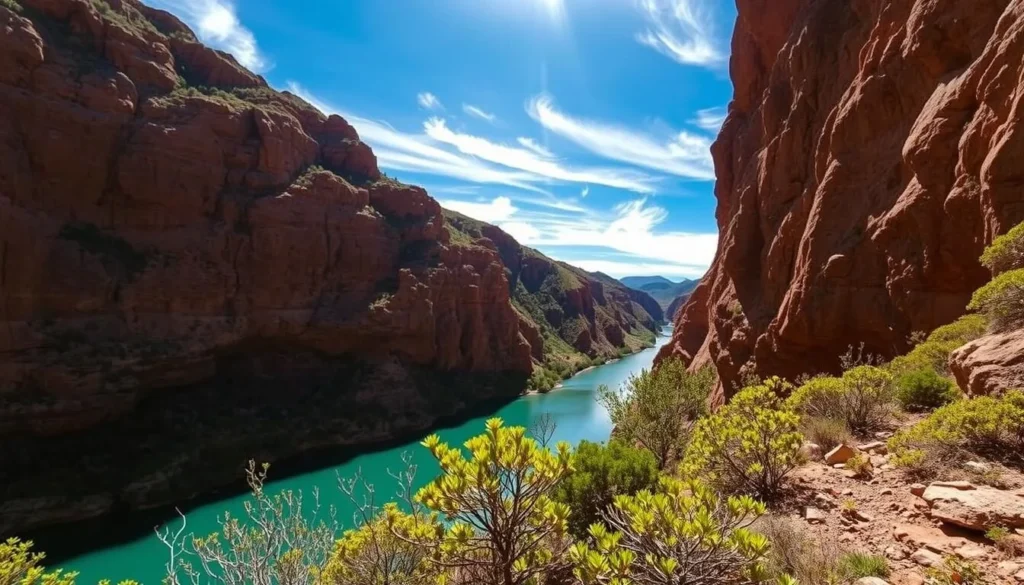
| Trail Name | Distance | Difficulty |
|---|---|---|
| Yardie Creek Gorge Trail | 2km | Moderate |
| Mandu Mandu Gorge Trail | varies | Easy to Moderate |
Visitors can enjoy the scenic views, spot rare wildlife such as the black-flanked rock wallabies, and experience the natural beauty of Cape Range National Park through its hiking trails and gorges.
Wildlife Spotting Opportunities
Cape Range National Park is a haven for wildlife enthusiasts, offering a diverse range of species to spot in their natural habitat. The park’s unique blend of marine and terrestrial ecosystems supports a wide variety of wildlife.
Marine Wildlife
The waters around Cape Range National Park are home to an impressive array of marine life. You can spot whale sharks, sea turtles, and numerous fish species while snorkeling or diving in the Ningaloo Reef. The park’s marine wildlife is a major draw for visitors, with many opportunities to see these creatures up close.
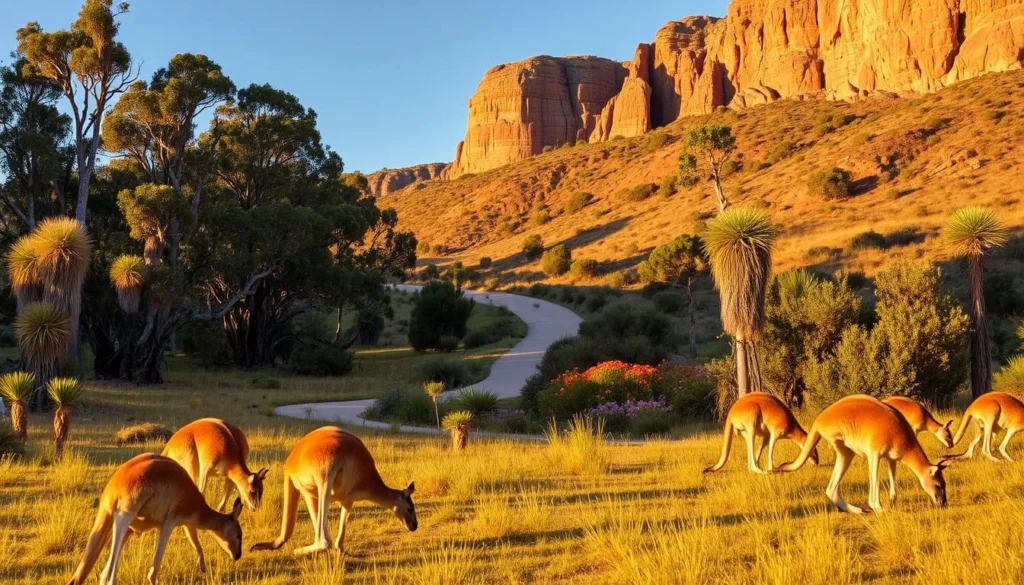
Land Animals and Birds
The park is also a haven for land animals and birds. You can spot red kangaroos, euros, and the rare black-flanked rock wallaby in the gorges. Birdwatchers will delight in the over 200 bird species recorded in the park, including ospreys, sea eagles, and fairy wrens. Mangrove Bay offers exceptional bird-watching opportunities with its purpose-built bird hide overlooking the lagoon.
| Wildlife | Location | Best Time to Spot |
|---|---|---|
| Red Kangaroos, Euros | Throughout the park | Dawn, Dusk |
| Black-flanked Rock Wallaby | Yardie Creek Gorge | Early Morning, Late Afternoon |
| Ospreys, Sea Eagles | Mangrove Bay | Anytime |
Must-Visit Attractions in Cape Range National Park
As you explore Cape Range National Park, you’ll discover a variety of must-visit attractions that highlight the park’s natural beauty and rich cultural heritage.
Charles Knife Canyon

Charles Knife Canyon is a breathtaking attraction within Cape Range National Park, known for its deep, narrow gorge and stunning limestone cliffs. You can take a guided tour to explore this natural wonder and learn about its geological history.
Milyering Discovery Centre
The Milyering Discovery Centre is a one-stop shop in the heart of Cape Range National Park, providing insights into both the park and Ningaloo Marine Park. This environmentally friendly building is constructed from rammed earth and powered by solar energy. The center offers a museum, aquarium, gift shop, and café, making it an ideal place to learn about the park’s unique ecosystems, geology, and cultural history. You can interact with knowledgeable park rangers who are available to answer questions and provide safety information.
- The Milyering Discovery Centre serves as the main visitor information hub for Cape Range National Park.
- The center is an architectural marvel, constructed from rammed earth and powered entirely by solar energy.
- Inside, you’ll discover comprehensive displays about the park’s unique ecosystems and cultural history.
- Knowledgeable park rangers are available to answer questions and offer recommendations.
- The center houses a small aquarium showcasing local marine species.
- Additional amenities include a gift shop, a small café, and clean restroom facilities.
- Free Wi-Fi is available at the center.
Accommodation Options Near Cape Range National Park
When planning your trip to Cape Range National Park, choosing the right accommodation is crucial for a memorable experience. You have the option to camp within the park or stay in the nearby town of Exmouth.
Camping Within the Park
Camping within Cape Range National Park allows you to immerse yourself in nature. You’ll wake up to the sound of birds chirping and enjoy stunning views right from your campsite. The park offers various camping sites, ranging from basic to more equipped facilities. Be sure to book your campsite in advance, especially during peak season.
Staying in Exmouth
Exmouth is a charming town that serves as the gateway to Cape Range National Park, located approximately 40 kilometers away via a sealed road that provides easy access to the park’s attractions. By staying in Exmouth, you’ll have access to a wider range of accommodation options, including luxury resorts, mid-range motels, and self-contained apartments. You can enjoy the town’s amenities, such as supermarkets, restaurants, and fuel stations. Exmouth also offers great beaches, like Bundegi Beach, and activities like kitesurfing lessons. While you’ll need to pay the entry fee each time you visit the park, staying in Exmouth provides a convenient base for your adventures.

Practical Information for Visitors
To make the most of your visit to Cape Range National Park, understanding the practical aspects is crucial. This includes knowing the park’s fees, opening hours, and how to get around effectively.
Park Fees and Opening Hours
Cape Range National Park is open daily, and the entry fee is applicable per vehicle. You can obtain the most current information on fees and opening hours at the park’s visitor center or through the official website. It’s also worth noting that some attractions within the park may have specific opening hours or guided tour schedules.
Getting Around
A conventional 2WD vehicle is sufficient for accessing most attractions within Cape Range National Park, as the main road is sealed all the way to Yardie Creek. However, a 4WD is necessary for crossing Yardie Creek or exploring rugged tracks like Shothole Canyon Road. Be cautious while driving, especially around dawn and dusk, as wildlife may be present on the roads. Additionally, be aware that there is no public transportation within the park, and mobile phone coverage is limited.
| Vehicle Type | Accessibility | Remarks |
|---|---|---|
| 2WD | Most attractions | Main road sealed to Yardie Creek |
| 4WD | Rugged tracks, Yardie Creek crossing | Necessary for Shothole Canyon Road |

Conclusion: Making the Most of Your Cape Range National Park Adventure
Your journey to Cape Range National Park promises to be an unforgettable experience. With its unique blend of rugged landscapes and pristine beaches, this national park in Western Australia offers diverse activities. Plan your visit between March to June for optimal time to enjoy the park’s beauty.
To truly immerse yourself, spend at least three days exploring the cape range and range national park’s attractions, including the Ningaloo reef. This will allow you to appreciate its natural beauty without rushing.
The above is subject to change.
Check back often to TRAVEL.COM for the latest travel tips and deals.
